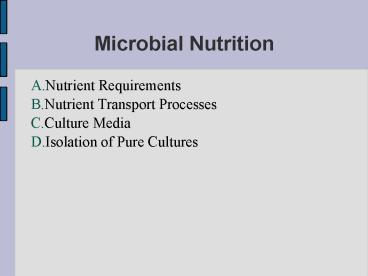Microbial Nutrition - PowerPoint PPT Presentation
1 / 23
Title:
Microbial Nutrition
Description:
ATP-binding cassette transporters (ABC transporters): The target binds to a ... The target-cassette complex then binds to an integral membrane ATPase pump that ... – PowerPoint PPT presentation
Number of Views:366
Avg rating:3.0/5.0
Title: Microbial Nutrition
1
Microbial Nutrition
- Nutrient Requirements
- Nutrient Transport Processes
- Culture Media
- Isolation of Pure Cultures
2
Nutrient Requirements
- Energy Source
- Phototroph
- Uses light as an energy source
- Chemotroph
- Uses energy from the oxidation of reduced
chemical compounds
3
Nutrient Requirements
- Electron (Reduction potential) Source
- Organotroph
- Uses reduced organic compounds as a source for
reduction potential - Lithotroph
- Uses reduced inorganic compounds as a source for
reduction potential
4
Nutrient Requirements
- Carbon source
- Autotroph
- Can use CO2 as a sole carbon source (Carbon
fixation) - Heterotroph
- Requires an organic carbon source cannot use CO2
as a carbon source
5
Nutrient Requirements
- Nitrogen source
- Organic nitrogen
- Primarily from the catabolism of amino acids
- Oxidized forms of inorganic nitrogen
- Nitrate (NO32-) and nitrite (NO2-)
- Reduced inorganic nitrogen
- Ammonium (NH4)
- Dissolved nitrogen gas (N2) (Nitrogen fixation)
6
Nutrient Requirements
- Phosphate source
- Organic phosphate
- Inorganic phosphate (H2PO4- and HPO42-)
7
Nutrient Requirements
- Sulfur source
- Organic sulfur
- Oxidized inorganic sulfur
- Sulfate (SO42-)
- Reduced inorganic sulfur
- Sulfide (S2- or H2S)
- Elemental sulfur (So)
8
Nutrient Requirements
- Special requirements
- Amino acids
- Nucleotide bases
- Enzymatic cofactors or vitamins
9
Nutrient Requirements
- Prototrophs vs. Auxotrophs
- Prototroph
- A species or genetic strain of microbe capable of
growing on a minimal medium consisting a simple
carbohydrate or CO2 carbon source, with inorganic
sources of all other nutrient requirements - Auxotroph
- A species or genetic strain requiring one or more
complex organic nutrients (such as amino acids,
nucleotide bases, or enzymatic cofactors) for
growth
10
Nutrient Transport Processes
- Simple Diffusion
- Movement of substances directly across a
phospholipid bilayer, with no need for a
transport protein - Movement from high ? low concentration
- No energy expenditure (e.g. ATP) from cell
- Small uncharged molecules may be transported via
this process, e.g. H2O, O2, CO2
11
Nutrient Transport Processes
- Facilitated Diffusion
- Movement of substances across a membrane with the
assistance of a transport protein - Movement from high ? low concentration
- No energy expenditure (e.g. ATP) from cell
- Two mechanisms Channel Carrier Proteins
12
Nutrient Transport Processes
- Active Transport
- Movement of substances across a membrane with the
assistance of a transport protein - Movement from low ? high concentration
- Energy expenditure (e.g. ATP or ion gradients)
from cell - Active transport pumps are usually carrier
proteins
13
Nutrient Transport Processes
- Active Transport (cont.)
- Active transport systems in bacteria
- ATP-binding cassette transporters (ABC
transporters) The target binds to a soluble
cassette protein (in periplasm of gram-negative
bacterium, or located bound to outer leaflet of
plasma membrane in gram-positive bacterium). The
target-cassette complex then binds to an integral
membrane ATPase pump that transports the target
across the plasma membrane.
14
Nutrient Transport Processes
- Active Transport (cont.)
- Active transport systems in bacteria
- Cotransport systems Transport of one substance
from a low ? high concentration as another
substance is simultaneously transported from high
? low. For example lactose permease in E.
coli As hydrogen ions are moved from a high
concentration outside ? low concentration inside,
lactose is moved from a low concentration outside
??high concentration inside
15
Nutrient Transport Processes
- Active Transport (cont.)
- Active transport systems in bacteria
- Group translocation system A molecule is
transported while being chemically modified.For
example phosphoenolpyruvate sugar
phosphotransferase systems (PTS)PEP sugar
(outside) ??pyruvate sugar-phosphate
(inside)
16
Nutrient Transport Processes
- Active Transport (cont.)
- Active transport systems in bacteria
- Iron uptake by siderophores Low molecular
weight organic molecules that are secreted by
bacteria to bind to ferric iron (Fe3) necessary
due to low solubility of iron Fe3- siderophore
complex is then transported via ABC
transporter
17
Microbiological Media
- Liquid (broth) vs. semisolid media
- Liquid medium
- Components are dissolved in water and sterilized
- Semisolid medium
- A medium to which has been added a gelling agent
- Agar (most commonly used)
- Gelatin
- Silica gel (used when a non-organic gelling agent
is required)
18
Microbiological Media
- Chemically defined vs. complex media
- Chemically defined media
- The exact chemical composition is known
- e.g. minimal media used in bacterial genetics
experiments - Complex media
- Exact chemical composition is not known
- Often consist of plant or animal extracts, such
as soybean meal, milk protein, etc. - Include most routine laboratory media, e.g.,
tryptic soy broth
19
Microbiological Media
- Selective media
- Contain agents that inhibit the growth of certain
bacteria while permitting the growth of others - Frequently used to isolate specific organisms
from a large population of contaminants - Differential media
- Contain indicators that react differently with
different organisms (for example, producing
colonies with different colors) - Used in identifying specific organisms
20
Pure Culture Technique
- Streak plate method
- Developed in the 1870s by Koch and his co-workers
- The objective to obtain isolated colonies
spots of microbial growth that come from a single
parent cell - The method streak the sample on semisolid
medium, containing a gelling agent - Agar the most commonly used gelling agent
21
Pure Culture Technique
22
Pure Culture Technique
23
Pure Culture Technique
- Spread plating pour plating
- Limiting dilution































